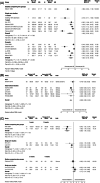Impact of low iodine diets on ablation success in differentiated thyroid cancer: A mixed-methods systematic review and meta-analysis
- PMID: 35484696
- PMCID: PMC9790217
- DOI: 10.1111/cen.14751
Impact of low iodine diets on ablation success in differentiated thyroid cancer: A mixed-methods systematic review and meta-analysis
Abstract
Background: Debate remains regarding whether to recommend a low iodine diet (LID) before radioactive-iodine treatment and its duration and stringency. This mixed-methods review aimed to determine if iodine status affects treatment success, the most effective diet to reduce iodine status, and how LID impacts wellbeing.
Methods: Five electronic databases were searched until February 2021. An effectiveness synthesis (quantitative studies) and views synthesis (qualitative, survey, and experience-based evidence) were conducted individually and then integrated. Quality assessment was undertaken.
Results: Fifty-six quantitative and three qualitative studies were identified. There was greater ablation success for those with an iodine status of <50 mcg/L (or mcg/gCr) compared with ≥250 (odds ratio [OR] = 2.63, 95% confidence interval [CI], 1.18-5.86, n = 283, GRADE certainty of evidence very low). One study compared <50 mcg/L (or mcg/gCr) to 100-199 and showed similar rates of ablation success (OR = 1.59, 95% CI, 0.48-6.15, n = 113; moderate risk of bias). People following a stricter LID before ablation had similar rates of success to a less-strict diet (OR = 0.67, 95% CI, 0.26-1.73, n = 256, GRADE certainty of evidence very low). A stricter LID reduced iodine status more than a less strict (SMD = -0.40, 95% CI, -0.56 to -0.24, n = 816), and reduction was seen after 1 and 2 weeks. The main challenges were a negative impact on psychological health, over restriction, confusion, and difficulty for sub-groups.
Conclusions: Although a LID of 1-2 weeks reduces iodine status, it remains unclear whether iodine status affects treatment success as only a few low-quality studies have examined this. LIDs are challenging for patients. Higher-quality studies are needed to confirm whether a LID is necessary.
Keywords: differentiated thyroid cancer; iodine status; low iodine diets; meta-analysis; mixed-methods systematic review.
© 2022 The Authors. Clinical Endocrinology published by John Wiley & Sons Ltd.
Conflict of interest statement
The authors declare no conflicts of interest.
Figures


References
-
- Perros P, Boelaert K, Colley S, et al. Guidelines for the management of thyroid cancer. Clin Endocrinol. 2014;81:1‐122. - PubMed
-
- Maxon HR, Thomas SR, Boehringer A, et al. Low iodine diet in I‐131 ablation of thyroid remnants. Clin Nucl Med. 1983;8(3):123‐126. - PubMed
-
- Haugen BR, Alexander EK, Bible KC, et al. 2015 American Thyroid Association management guidelines for adult patients with thyroid nodules and differentiated thyroid cancer: the American Thyroid Association Guidelines Task Force on thyroid nodules and differentiated thyroid cancer. Thyroid. 2016;26(1):1‐133. - PMC - PubMed
-
- Ito Y, Onoda N, Okamoto T. The revised clinical practice guidelines on the management of thyroid tumors by the Japan Associations of Endocrine Surgeons: Core questions and recommendations for treatments of thyroid cancer. Endocr J. 2020;67(7):669‐717. - PubMed
Publication types
MeSH terms
Substances
Grants and funding
LinkOut - more resources
Full Text Sources
Medical

